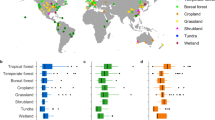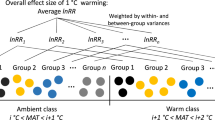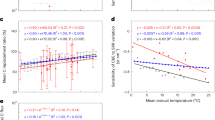Abstract
Soil organic carbon (SOC) cycling schemes used in land surface models (LSMs) typically account only for the effects of net primary production and heterotrophic respiration1. To demonstrate the significance of omitting soil redistribution in SOC accounting, sequestration and emissions, we modified the SOC cycling scheme RothC (ref. 2) to include soil erosion. Net SOC fluxes with and without soil erosion for Australian long-term trial sites were established and estimates made across Australia and other global regions based on a validated relation with catchment-scale soil erosion. Assuming that soil erosion is omitted from previous estimates of net C flux, we found that SOC erosion is incorrectly attributed to respiration. On this basis, the Australian National Greenhouse Gas inventory overestimated the net C flux from cropland by up to 40% and the potential (100 year) C sink is overestimated by up to 17%. We estimated global terrestrial SOC erosion to be 0.3–1.0 Pg C yr−1 indicating an uncertainty of −18 to −27% globally and +35 to −82% regionally relative to the long-term (2000–2010) terrestrial C flux of several LSMs. Including soil erosion in LSMs should reduce uncertainty in SOC flux estimates3,4 with implications for CO2 emissions, mitigation and adaptation strategies and interpretations of trends and variability in global ecosystems5.
This is a preview of subscription content, access via your institution
Access options
Subscribe to this journal
Receive 12 print issues and online access
$209.00 per year
only $17.42 per issue
Buy this article
- Purchase on Springer Link
- Instant access to full article PDF
Prices may be subject to local taxes which are calculated during checkout


Similar content being viewed by others
References
King, A. W., Post, W. M. & Wullschleger, S. D. The potential response of terrestial carbon storage to changes in climate and atmospheric CO2 . Climatic Change 35, 199–227 (1997).
Jenkinson, D. S. The turnover of organic carbon and nitrogen in soil. Phil. Trans. R. Soc. Lond. B 329, 361–368 (1990).
Todd-Brown, K. E. O. et al. Changes in soil organic carbon storage predicted by Earth system models during the 21st century. Biogeosciences 11, 2341–2356 (2013).
Tian, H. et al. Global patterns and controls of soil organic carbon dynamics as simulated by multiple terrestrial biosphere models: Current status and future directions. Glob. Biogeochem. Cycles 29, 775–792 (2015).
Ahlstrom, A. et al. The dominant role of semi-arid ecosystems in the trend and variability of the land CO2 sink. Science 348, 895–899 (2015).
Lal, R. Soil erosion and the global carbon budget. Environ. Int. 29, 437–450 (2003).
IPCC Climate Change 1992: The Supplementary Report to the IPCC Scientific Assessment, Report of the Intergovernment Panel on Climate Change (eds Houghton, J. T., Callander, B. A. & Varney, S. K.) (Cambridge Univ. Press, 1992).
Giorgi, F. Climate change hot-spots. Geophys. Res. Lett. 33, L08707 (2006).
Potter, C. S. et al. Terrestrial ecosystem production: A process model based on global satellite and surface data. Glob. Biogeochem. Cycles 7, 811–841 (1993).
Lal, R. Soil degradation by erosion. Land Degrad. Dev. 12, 519–539 (2001).
Montgomery, D. R. Soil erosion and agricultural sustainability. Proc. Natl Acad. Sci. USA 104, 13268–13272 (2007).
Chappell, A., Viscarra Rossel, R. A. & Loughran, R. Spatial uncertainty of 137Cs-derived net (1950s–1990) soil redistribution for Australia. J. Geophys. Res. 116, F04015 (2011).
Chappell, A. et al. The dynamics of soil redistribution and the implications for soil organic carbon accounting in agricultural south-eastern Australia. Glob. Change Biol. 18, 2081–2088 (2012).
Marx, S. K. et al. Unprecedented wind erosion and perturbation of surface geochemistry marks the Anthropocene in Australia. J. Geophys. Res. 119, 45–61 (2014).
CSIRO & Bureau of Meteorology Climate Change in Australia Information for Australia’s Natural Resource Management Regions Technical Report (CSIRO and Bureau of Meteorology, 2015).
Van Oost, K. et al. The impact of agricultural soil erosion on the global carbon cycle. Science 318, 626–629 (2007).
Quinton, J. N., Govers, G., Van Oost, K. & Bardgett, R. D. The impact of agricultural soil erosion on biogeochemical cycling. Nature Geosci. 3, 311–314 (2010).
Parton, W. J., Schimel, D. S., Cole, C. V. & Ojima, D. S. Analysis of factors controlling soil organic matter levels in Great Plains grasslands. Soil Sci. Soc. Am. 51, 1173–1179 (1987).
McCown, R. L. APSIM: A novel software system for model development, model testing, and simulation in agricultural systems research. Agric. Syst. 50, 255–271 (1996).
Wang, Y.-P., Law, R. M. & Pak, B. A global model of carbon, nitrogen and phosphorus cycles for the terrestrial biosphere. Biogeosciences 7, 2261–2282 (2010).
Skjemstad, J. O., Spouncer, L. R., Cowie, B. & Swift, R. S. Calibration of the Rothamsted organic turnover model (RothC ver. 26.3), using measurable soil organic carbon pools. Aust. J. Soil Res. 42, 79–88 (2004).
Doetterl, S., Van Oost, K. & Six, J. Towards constraining the magnitude of global agricultural sediment and soil organic carbon fluxes. Earth Surf. Process. Landf. 37, 642–655 (2012).
Department of Environment (2011) Australian National Greenhouse Gas Inventory, Kyoto Protocol Accounting Framework (accessed 28 March, 2014); http://ageis.climatechange.gov.au
Luo, Z., Wang, E., Baldock, J. & Xing, H. Potential soil organic carbon stock and its uncertainty under various cropping systems in Australian Cropland. Soil Res. 52, 463–475 (2014).
Dalal, R. C. & Chan, K. Y. Soil organic matter in rainfed cropping systems of the Australian cereal belt. Aust. J. Soil Res. 39, 435–464 (2001).
Smith, S. V., Renwick, W. H., Buddemeier, R. W. & Crossland, C. J. Budgets of soil erosion and deposition for sediments and sedimentary organic carbon across the conterminous United States. Glob. Biogeochem. Cycles 15, 697–707 (2001).
Gregorich, E. G., Greer, K. J., Anderson, D. W. & Liang, B. C. Carbon distribution and losses: Erosion and deposition effects. Soil Tillage Res. 47, 291–302 (1998).
Chappell, A., Webb, N. P., Viscarra Rossel, R. A. & Bui, E. Australian net (1950s–1990) soil organic carbon erosion: Implications for CO2 emission and land-atmosphere modelling. Biogeosciences 11, 6793–6814 (2014).
Harden, J. W. et al. Dynamic replacement and loss of soil carbon on eroding cropland. Glob. Biogeochem. Cycles 13, 885–901 (1999).
Berhe, A. A., Harte, J., Harden, J. W. & Torn, M. S. The significance of the erosion-induced terrestrial carbon sink. BioSciences 57, 337–346 (2007).
Acknowledgements
Financial support for this research was provided by CSIRO Agriculture. The authors are grateful to Y. Li for providing the 137Cs measurements and to P. Canadell, Z. Luo and R. Farquharson for comments on early versions of the document. Any errors or omissions in the manuscript remain the responsibility of the authors.
Author information
Authors and Affiliations
Contributions
A.C. conceived of the project in consultation with J.B. and J.S. J.S. organized the soil samples and measurement of 137Cs and A.C. calculated the estimates of soil redistribution. A.C. wrote the code in Matlab to analyse the data, performed the analyses and interpreted the results in consultation with J.B. and J.S. A.C. led the manuscript writing with contributions from J.B. and J.S.
Corresponding author
Ethics declarations
Competing interests
The authors declare no competing financial interests.
Supplementary information
Rights and permissions
About this article
Cite this article
Chappell, A., Baldock, J. & Sanderman, J. The global significance of omitting soil erosion from soil organic carbon cycling schemes. Nature Clim Change 6, 187–191 (2016). https://doi.org/10.1038/nclimate2829
Received:
Accepted:
Published:
Issue Date:
DOI: https://doi.org/10.1038/nclimate2829
This article is cited by
-
A new high-resolution global topographic factor dataset calculated based on SRTM
Scientific Data (2024)
-
Microbially mediated mechanisms underlie soil carbon accrual by conservation agriculture under decade-long warming
Nature Communications (2024)
-
Temperature effect on erosion-induced disturbances to soil organic carbon cycling
Nature Climate Change (2023)
-
Integrating terrestrial and aquatic ecosystems to constrain estimates of land-atmosphere carbon exchange
Nature Communications (2023)
-
EUSEDcollab: a network of data from European catchments to monitor net soil erosion by water
Scientific Data (2023)



